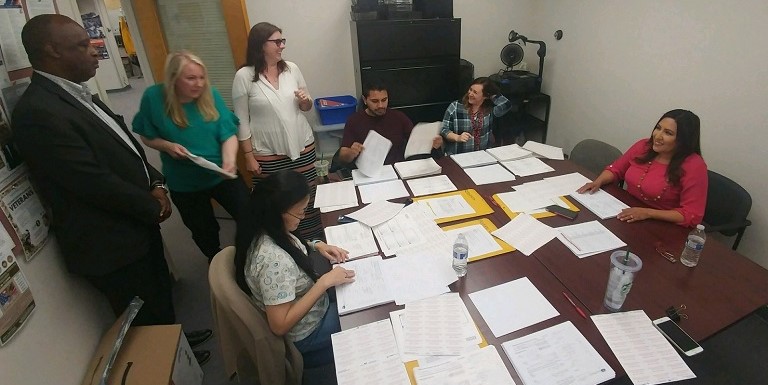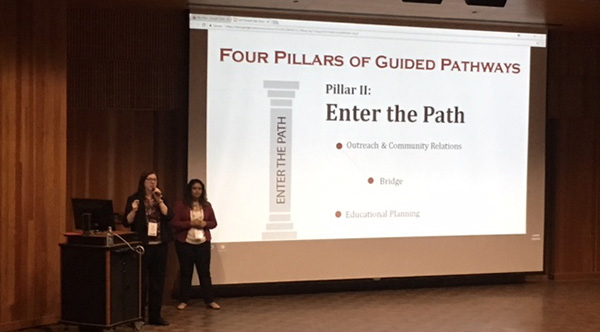Cost Benefits of Adopting a Guided Pathways Model

On February 3, 2021, I participated in a California panel discussion hosted by the Community College Research Center (CCRC) at Columbia University that addressed the cost benefits of adopting a guided pathways model. The discussion focused on two CCRC reports: The Economics of Guided Pathways: Cost, Funding, and Value (Belfield, 2020) and Funding Guided Pathways: A Guide for Community College Leaders (Jenkins et al., 2020). Based on my experience as President of Bakersfield College (BC), I assert that both reports can be extremely useful for administrators responsible for budgets, best practices, and tools to advance guided pathways work at their colleges as well as for policymakers who want to ensure that the public will benefit from investments to adopt and scale up the guided pathways model.
So, what are guided pathways? In 2015, Bailey, Smith Jaggars, and Jenkins published Redesigning America’s Community Colleges, which introduced a framework of redesign for colleges moving from an access model (ensuring that students have open access to education) to a success with equity model (designing curricula and support systems to facilitate larger numbers of students getting to the finish line while simultaneously closing equity gaps). Briefly put, the pathways model aims to be effective and efficient, with more students completing a degree in a shorter amount of time with fewer credits, while ensuring that college outcomes are not artifacts of inequity.
The guided pathways framework is as much a philosophical foundation as an operational roadmap for colleges looking to shift their campus to a student success with equity model. This framework is structured around four pillars: clarifying the path, entering the path, staying on the path, and ensuring learning. At BC, we clarify the path by making the required sequencing of courses visible to students using a customized representation of the college’s catalog—the Program Pathways Mapper. This tool helps students to make informed choices to reach their goals more efficiently. Entering the path means developing starting points that are precise, intentional, and well-supported. For instance, BC’s Early College program works with area high schools to enroll students in college courses while they are still in high school, following specific course patterns so that they can earn an associate degree as they earn their high school diploma. For more traditional students, Summer Bridge to BC is a one-week high-touch, high-tech online course for incoming freshman to help jump start their academic success. To help students stay on the path, we have created hubs of student support—interdepartmental completion coaching teams—that have reshaped the support system based on the principle that it is far easier to make smaller adjustments earlier than to make larger corrections later. And finally, we ensure learning by developing an environment in which the learning is relevant and accessible to the learner. Internships, on-campus jobs, field trips, and project-based learning create opportunities for our students to see the benefits of their education in real time.
In The Economics of Guided Pathways (2020), Belfield noted that the average implementation cost for guided pathways for a school with 4,000 FTE is approximately $7.1 million. Additionally, the average operating cost after the initial investment averages about $350 per FTE per year. A major portion of start-up costs involves hiring additional advisors as well as ensuring release time for faculty and staff to work on program mapping, information technology investment, and other related actions.

The 12 community colleges that implemented guided pathways reforms in Belfield’s (2020) study realized a significant return on investment of these startup costs; every college continued with the guided pathways plan because of cost savings to the student, faster path to degree completion, and increased efficiency of the college as a business. In some ways, implementing guided pathways for students creates a type of guided pathway for the college itself. Just as we are creating easy-to-understand paths for students to follow, implementing guided pathways helps faculty, staff, and administrators see the path to making deep structural improvements in how we achieve the fundamental outcome of our mission: student success with equity. The shift in focus from open access to success with equity based on the four pillars of the guided pathways framework forces colleges to redesign workflow into integrated networks of collaboration with the sole purpose of improving student success with equity rather than perpetuating organizational silos.
Making degrees and certificates more effective and efficient for our students necessarily requires colleges to be more effective and efficient as well. The initial investment in rethinking what we do and how we do it at BC has resulted in a collaborative culture, streamlined structures, and student-focused practice; this, in turn, has improved our budgets, allowed us to find inefficiencies, and ensured that every part of our college is working toward one goal without inadvertently working at cross purposes between departments. In fact, we have boosted our college budget from about $80M to $180M during the time of our work with guided pathways. BC’s investments can be characterized by (1) smartly investing resources that accelerate the trajectory of impact, (2) recasting work to scale up with fewer steps, and (3) focusing on results that improve outcomes and create an abundance that can be reinvested in future growth and success cycles.
One of the policy levers that has been triggered by states to incentivize student degree completion is performance-based funding. In September 2020, Whitford reported that as of the 2020 fiscal year, 41 states had implemented some level of performance-based funding. These policies can vary wildly, depending on what is tied to funding, and depending on how performance and student success are defined. Community colleges have been criticized in the past for having revolving doors, where students enter and exit without obtaining a degree or certificate and funding based only on enrollments and not success might incentivize access without success. There have also been concerns raised that performance-based funding could have a negative impact on resource availability for equity work. In California, the new Student Centered Funding Formula has attempted to address these issues by building the formula on three components—enrollment, performance, and equity—which create safeguards for colleges as we move from a purely enrollment-based funding model to one that takes into account success with equity.
In 2016, astronomy professor Nick Strobel made the business case for guided pathways at BC’s Redesigning Community College summit. During a session on guided pathways implementation, he shared that there is a boon to the tax base when we increase our students’ success. An associate degree holder contributes $11,640 more over the span of 30 years than would a high school graduate, and a bachelor’s degree holder contributes $49,350 more over 30 years (Strobel, 2016). The taxpayer investment into the community college system pays dividends later on that allow us to reinvest in our institutions.
Belfield (2020) shared additional positives for the taxpayer. The upfront and ongoing investment in guided pathways is offset by students getting through the system more quickly. He also echoed Strobel’s finding that more students persisting to higher degrees means eventual gains to the state economy through better-paying jobs and less need for public assistance (Belfield, 2020).
In his research, Belfield (2020) uses a methodology that looks at all of the “ingredients” of the bigger picture when analyzing budgets: Resources are ingredients; every program has ingredients; and every ingredient has a cost, including those things that might be used but not directly paid for. By itemizing every ingredient (e.g., faculty reassignment time or additional stipends), we can see the true cost of a program across multiple departments with multiple needs, including funding from multiple agencies and other sources. This allows us to better understand what will happen as we scale up our guided pathways program. BC costs included paying stipends for completion coaching team faculty lead roles, implementing our innovative program mapping tool, updating the website, purchasing and maintaining scheduling software, providing professional development opportunities, and more—all ingredients and costs that are spread out over separate departments. Funding sources included grants, categorical state funds, and reorganized staff roles, again, spread out over programs and departments. This methodology allows a whole college redesign without overlooking costs or missing opportunities for funding.
Preparing our students better now means preparing them to be focused and flexible as they adjust and adapt to an ever-changing world. These qualities are not always well-suited to a traditional educational system. We must embrace the idea that systemic and integrated changes, both large and small, will cumulatively create a whole that is greater than the sum of its parts. Colleges cannot operate with a conservative business mindset of status quo, linear growth, and making isolated incremental changes. Done well, how we prepare our students will have a self-amplifying effect on their ability to navigate a changed world.
The impetus to measure educational effectiveness by efficiency in resource use can be consistent with ensuring student success with equity. These are not antithetical concepts—it depends on what is measured and how it is measured. And regardless of a state’s funding model, it is incumbent on college faculty, staff, and administrators working together to maximize student success with equity.
Guided pathways provides a clear model for implementing changes that move a college from prioritizing access to maximizing both access and success with equity. The evidence that investing in a guided pathways model will reap untold benefits for our students, our colleges, and our communities and society at large is compelling.
References
Bailey, T., Smith Jaggars, S., & Jenkins, D. (2015). Redesigning America's community colleges: A clearer path to student success. Harvard University Press.
Belfield, C. (2020). The economics of guided pathways: Cost, funding, and value (CCRC Working Paper No. 123). Columbia University, Teachers College, Community College Research Center. https://ccrc.tc.columbia.edu/media/k2/attachments/economics-guided-pathways-cost-funding-value.pdf
Jenkins, D., Brown, A. E., Fay, M. P., & Lahr, H. (2020). Funding guided pathways: A guide for community college leaders. Columbia University, Teachers College, Community College Research Center. https://ccrc.tc.columbia.edu/media/k2/attachments/funding-guided-pathways-guide.pdf
Strobel, N. (February 18, 2016). Budget implications of guided pathways [Conference session]. Redesigning Community Colleges, Bakersfield, CA, United States. https://www.bakersfieldcollege.edu/conference/redesigning-community-colleges
Whitford, E. (2020). Report examines years of performance-based funding studies. Inside Higher Ed. https://www.insidehighered.com/quicktakes/2020/09/16/report-examines-years-performance-based-funding-studies
Sonya Christian is President at Bakersfield College in Bakersfield, California.
Opinions expressed in Innovation Showcase are those of the author(s) and do not necessarily reflect those of the League for Innovation in the Community College.










